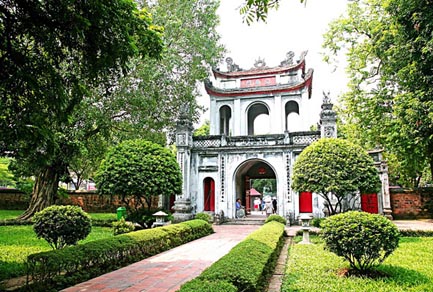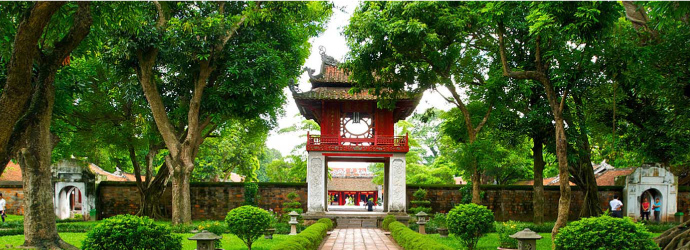Tailor Made Holidays with our travel experts
We'll do our best to call you within 48h

Lying in the Red river delta where the land is fertile, Thang Long-Hanoi has survived to the age of a thousand years as of 2010. As a political and religious centre of Vietnam since the beginning of the country’s history, Thang Long-Hanoi pools together all the aspects of culture and civilisation that are quintessentially Vietnamese. Hanoi is the capital of Vietnam and is the second most populous city in the country with approximately 4 million people. Compared to Ho Chi Minh City, Hanoi is more traditional and refined. Today it is best known for its thriving contemporary arts scene and French architecture, visible by the many colonial villas scattered throughout the city. While it is rapidly developing, the city has retained many of its cultural traditions. Observe elderly people practicing Tai Chi by the lake or witness traditional festivals during the Lunar New Year. Hanoi has a vibrant “street culture” where daily activities, such as hair cutting and eating at food stalls, take place on cramped sidewalks. As Hanoi is becoming more populated with people and automobiles, the city is experiencing more traffic congestion, particularly in the Old Quarter.
Settled since prehistoric times, Hanoi has been an important city throughout Vietnamese history, serving as the capital of a number of Vietnamese dynasties. Following the end of the Vietnam War, Hanoi became the capital of the country. Today, Hanoi provides a rich blend of new and old Vietnam, from the thousands of young workers on scooters streaking down the wide Parisian-style boulevards, to the chic fusion restaurants housed in former colonial buildings. Even as the city buzzes with heavy development and modernization, it retains its idyllic charm. Enjoy Hanoi’s tranquil parks and lakes, peruse galleries filled with emerging Vietnamese artists and fashion designers, and sample the city’s amazing cuisine and bustling street life.
This delta is the second cradle of rice culture in Vietnam, after the Mekong Delta in the south. With its strategic position, Ha noi was chosen as the capital of an independent country in 1010 under the name Thang long or Dragon taking off. Through several different dynasties as: Ly, Tran, Le, Trinh … in 1802, Ha noi lost its role to give it to Hue in the center of the country – the World Cultural Heritage listed by UNESCO today.
But most importantly, after the conquest of Indochina, the French chose Ha noi as the capital of French Indochina comprising: Vietnam, Laos and Cambodia. Having its turbulent history, Ha noi – the city inside the water manages to retain its charm of a perfect blend between the oriental styles: pagodas, temples, markets … and the French style: Villa, opera, shaded boulevards…
Since the opening of the country at the beginning of the 90s of the 20th century, the harmony between the past and the present, between antiquity and modernity has made the city an amazing diversity. Equipped of good infrastructure as: hotel, airport, and train station…, Ha noi becomes an indispensable step for all travelers around the world.
The old capital of Vietnam is full of excitement and intrigue. It is a city that has managed to preserve much of its history and colonial character, while still offering the dynamic hustle and bustle of an Asian metropolis. The old town quarter in the heart of the city and where to get a true taste of how Hanoi must have felt years ago. To get lost in the magical (and confusing) labyrinth of narrow, busy streets is a memorable experience and you always stumble upon something special. There are silk shops selling traditional Ao Dai dresses, scrumptious street food, a cozy café to sip Vietnamese coffee, or little bars serving bia-hoi (beer unique to Vietnam). This is also where some of Hanoi’s most attractive French architecture is located, just watch out for motorcyclists!
If fresh air and nature is what you seek, the city is renowned for its many lakes and small parks. The West Lake is the largest and a popular spot for lunch, view ornate neighbouring temples or to take a boat out on the water. The city has many outstanding cultural attractions. The Vietnam Museum of Ethonology is a fascinating place to learn about the many ethnic tribes living in the country. Equally interesting is the Temple of Literature, built in 1070 is the country’s first university dedicated to Confucius and is home to the archives of the ancient mandarins.
Nearby Mai Chau is the ideal antidote for the action and fast pace of Hanoi. A serene and picturesque valley, it’s home to the friendly and colourfully-clothed White Thai tribe. Hiking and bike rides are popular activities as nature and tranquility are all here in abundance. If you’re tempted to see this city from an insiders perspective in luxurious fashion, trust that Ethnic Voyage's team have the expert knowledge to provide a trip which gives you a well rounded escape to this tantalizing destination.
The tourist trail through Vietnam is well marked as thousands of wanderers make their vertical trek between Saigon (Ho Chi Minh City) and Hanoi. While the trail is certainly dotted with some of the country's unequivocal highlights - Sapa, Halong Bay, Hoi An, Mekong Delta - here's a list of some of Vietnam's lesser-known gems that will have you away from the tourists, and immersed in a sea of conical hats.
Old Quarter
Explore the bustling streets of Hanoi’s Old Quarter, with its small shops and charming cafés. You will notice that some of the alleyways are named for the guilds that established themselves in this area as far back as the 13th century. For example, Pho Hang Gai translates to “Silk Street,” and silk products are still sold here, although that is not the case on every street. In addition to locally made handicrafts, you will also find all manner of goods – herbal medicines, plumbing supplies, wooden carvings and boxes, textiles, rice paper notebooks, greeting cards, and more. If you wish, explore the Old Quarter by traditional rickshaw.
Hoa Lo Prison
One of the most notorious sites from the Vietnam War is the Hoa Lo Prison, better known by its ironic nickname of "Hanoi Hilton." It was built by the French in the late 19th century to house Vietnamese political prisoners – those opposed to colonization – and called Maison Centrale. Its Vietnamese name is derived from the street it is located on, and is far less sarcastic; it literally means stove but can be translated as “fiery furnace.”
Temple of Literature
Visit the serene Temple of Literature, built in the 11th-century to honor academics. The Temple grounds also housed Vietnam’s first university, in operation there until the 19th century, and include Hanoi’s best-preserved buildings and immaculate gardens.

Tran Quoc Pagoda
With an expert guide, visit the stunning Buddhist Tran Quoc Pagoda, perhaps the oldest pagoda in the country. Purportedly founded 1,400 years ago by King Ly Nam De, the building was originally named “Khai Quoc,” which translates to "Establishing the Nation."
Thang Long Water Puppet Theater
Visit Thang Long Water Puppet Theater, which, if you can forgive the canned music, is a good opportunity to see this traditional Vietnamese art form. Various puppets known as Mua roi nuoc by locals, be they dragons, dogs, or people, are brought to life with grace and precision on the surface of the water in this 20-minute show.
Hanoi Opera House
Peek behind the scenes at the Opera House, a smaller scale version of Palais Garnier in Paris and a remarkable example of French colonial architecture. Depending on the opera’s schedule, you will have a chance to chat with performers during breaks in rehearsal for an upcoming show.
Museum of Ethnology
Hanoi’s Museum of Ethnology offers a comprehensive overview of the country’s 54 ethnic minorities through its colorful, interactive displays. Examine the similarities and differences in tradition, clothing, language, and other markers of cultural identity among these diverse groups of people. Meet with a senior curator for deeper insights on the exhibits.
Sepak Takraw or Da Cau
Stop in the Hanoi Sports Department to learn how to play sepak takraw, which combines elements of volleyball, gymnastics, martial arts, and soccer. The sport is called da cau in Vietnam, but is known internationally as sepak takraw, from the Malay word sepak for “kick” and the Thai word takraw for “woven ball.”
Hoan Kiem Lake
Go for an early morning bicycling or walking tour of Hoan Kiem Lake (which means “Lake of the Returned Sword”), a tranquil and scenic spot where locals come to relax and socialize. The surrounding park is a popular spot to practice the ancient, meditative art of tai chi.